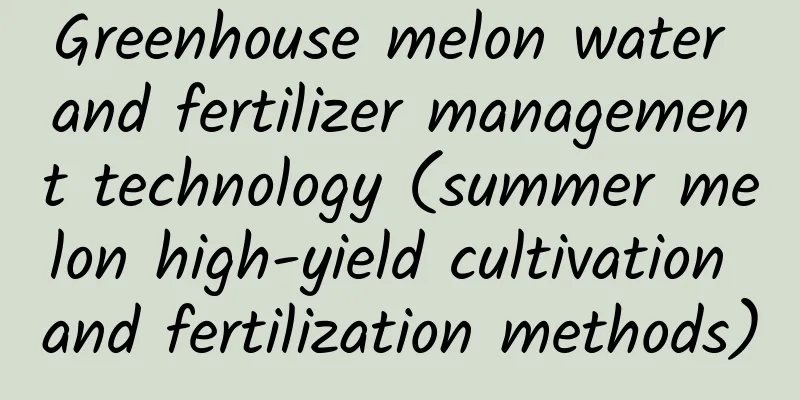Greenhouse melon water and fertilizer management technology (summer melon high-yield cultivation and fertilization methods)

Water and fertilizer management technology for greenhouse melon ① Planting After the melons are planted but before they start to vine, they need less water . Watering should be controlled to prevent lowering the ground temperature and promote root growth. ② Extension period When the melon spider enters the vine extension stage, the water requirement gradually increases. Water once during the vine extension period to promote stem and vine growth . ③Flowering period During the flowering and fruiting period of melons, the soil and air should be kept moist to extend the pollination time, which is beneficial to pollen germination and young fruit enlargement. The soil should be kept dry and wet at the same time, thus promoting fruit setting. ④ Water and fertilizer during fruit setting period After the melons are firmly planted, the melon plant needs a lot of water and is very sensitive to water shortage . If the water needs of fruit development cannot be met, cell elongation will be restricted and it will not expand normally, and the fruit will become significantly smaller or even deformed. Therefore, the number and amount of irrigation can be appropriately increased to keep the soil moist, but it is also not advisable to irrigate too much at one time to cause waterlogging on the ground. ⑤ Water and fertilizer management during fruit expansion period When the melons enter the late stage of swelling, the amount of watering should be controlled, and watering should be stopped 7 days before harvest to improve the quality and appearance of the commercial melons. This can prevent the fruit from being too wet, which will cause the fruit flavor to become lighter, and avoid cracking and rot during transportation and marketing. Topdressing technology for spring melon in greenhouseThe topdressing plan for melons in greenhouses depends on soil type, fertility level, climatic conditions, variety and planting density. Generally, 5kg of Jinkede silicone fertilizer is used to fertilize one acre of melon, once after the seedlings have grown, at the early flowering stage, and at the early fruiting stage, to promote root growth and increase root capacity. This method of top dressing shortens the internodes of melons, prevents excessive growth, improves pollen vitality, increases flowering and fruiting, increases skin hardness, makes fruits more resistant to impact, extends the shelf life by 7-15 days, and improves the taste. Technology and methods of foliar fertilization of melon① Seedling stageMix 30ml of Jinkede silicone foliar fertilizer in a spray pot (30 pounds of water), spray once every 7 to 10 days, spray twice . ②Growth periodMix 50ml of Jinkede silicone foliar fertilizer in a spray pot (30 kilograms of water), spray once every 7 to 10 days, and spray 4 to 6 times continuously . ③Long-termMix 80ml of Jinkede silicone foliar fertilizer in a spray pot (30 pounds of water), spray once every 7 to 10 days, and spray 3 to 4 times in a row. After spraying in this way, the melon plants will grow strong, with thick leaves and high chlorophyll content, which will improve photosynthesis, increase pollen vitality, produce more flowers and fruits, and increase production by 10%-20% . If the melons are put on the market 5-7 days earlier , the melon skin will be thin, the flesh will be crisp and sweet, and the sugar content will be high. In addition, in terms of pests and diseases, vine blight, wilt, virus disease, spider mites, melon aphids, leafminers and other pests and diseases will be significantly reduced. |
>>: When is the best time to plant ginger (when is the best time to plant fresh ginger in the south)
Recommend
Camellia's water requirements
1. Watering frequency Camellia likes water during...
The fastest way to root Osmanthus fragrans cuttings
Time for cutting of Osmanthus fragrans The most s...
How often should peanuts be watered?
How often should peanuts be watered? Water the pe...
How to care for banyan bonsai in winter
Is the banyan bonsai afraid of freezing? Banyan t...
What does water accumulation mean for growing flowers?
1. What does it mean? Waterlogging when growing f...
How to grow gorse
1. Soil selection It has strong adaptability and ...
Does climbing rose prefer shade or sun?
Does climbing rose prefer shade or sun? Climbing ...
How long does it take for jade ball cuttings to take root? The method of cuttings that takes root quickly
Jade balls are jade beads. If they are propagated...
The difference between Xianfeng grass and Bidens pilosa
1. Differences in stems Xianfeng grass is an annu...
The efficacy and function of chrysanthemum
The efficacy and function of chrysanthemum Edible...
Can white orchids be pruned?
In fact, it is best not to prune the white jasmin...
How to grow passion fruit in a pot (techniques and illustrations)
1. Planting method 1. Seeds: In August to October...
Where is pepper suitable for growing?
Growth habits of pepper Pepper is usually planted...
Jasmine is long-lived... hurry up and prune it ruthlessly, or the flowers won’t bloom a few days later!
Hurry up and cut the roses now, so they can bloom...
Can durian seeds be planted?
Can durian seeds be planted? Durian seeds can be ...









